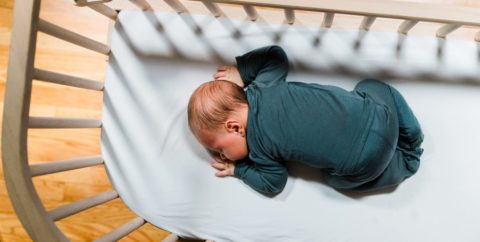why crib safety matters
Babies spend a lot of time sleeping. And when we say a lot, we mean it. The National Sleep Foundation recommends that newborns get between 14-17 hours of sleep a day. Which is why crib safety standards are such an important thing for parents to understand (and to check off the list when it comes to making sure their baby’s bed is up to 5-star safety snuff!)…
Because your baby spends more time snoozing away in their bedside co-sleeper, baby bassinet, or crib than they spend in any other room — or on any other piece of furniture — in your house. 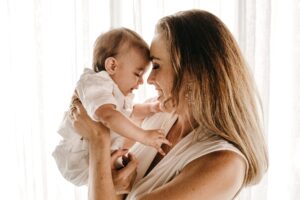
And though crib safety standards are something that are pretty important when it comes to ensuring your little one’s safety all night long, it can be difficult to understand how crib safety standards should affect your choice of bedside co-sleeper or crib model. Or to cut through all the formal lingo to understand what’s really going on so you can pick a crib that will let you rest easy while knowing your baby is peacefully sleeping away in perfect comfort and security.
So we’re about to break down the importance of crib safety standards in ways that are a little easier to understand. Stick around to see how to choose a crib or bedside co-sleeper that measures up to full peace of mind for you and your little one.
First Thing’s First: Who Sets Baby Crib Safety Standards and Guidelines?
The Consumer Product Safety Commission is the head office tasked with overseeing the safety of cribs. This is the agency of the U.S. government that oversees the safety of consumer products (as their name suggests) and sets general safety standards for how and when products can be used.
There are a few general guidelines that all manufacturers of baby products must follow, as well as a few tests they must pass.
For the most part, these tests address and regulate things like lead content and phthalate content (aka: chemicals that make plastics more durable, but aren’t the healthiest for your little one).
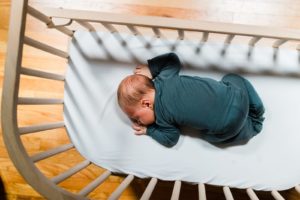
But when it comes to baby cribs, things get a little more complicated. Especially when it comes to the mechanical and construction side of things.
Believe it or not, the Consumer Product Safety Commission didn’t set mandatory crib safety standards for manufacturers until 2011.
Up until then, there were recommended safety guidelines that baby crib manufacturing companies were asked to follow — but none that were considered set in stone, non-negotiable “must-dos.”
Though many parents are interested in how to make an old crib safe, the CPSC considers old and vintage cribs (no matter how beautiful or decorative they are!) one of their “Most Wanted” dangerous products. 
And for good reason! One slight design flaw — like slats that are set too far apart or a decorative pattern in the wrong place — can easily become unsafe for babies. And any corner posts that aren’t well-constructed can easily catch on a newborn’s clothes and pose a risk.
This is why when it comes to choosing the best baby co-sleeper, bedside crib, bedside bassinet, or standalone crib for your little one, it’s a good idea to stop looking for how to make an old crib safe and instead seek out a crib or co-sleeper designed with safety as the top priority.
It’s also important to stay away from ones that were produced before those stricter safety standards were introduced in 2011. Because no matter how cute that vintage crib you find at an antique shop might be…there’s no guarantee that it will be safe for your little one to rest in all night long.
Are There Really Best Baby Cribs That Take the Top Spot for Safety?
Sure, safety standards might now be mandatory (thanks to the Consumer Product Safety Commission!). But that doesn’t mean that all baby crib or baby co-sleeper manufacturers think of safety the same way.
Many baby product manufacturers still consider safety as a “must do,” rather than a mission.
At the end of the day, there’s a big difference between checking off all the safety boxes and going above and beyond to give your baby a space to rest their head that is safe, secure, and perfectly built to support them through their many hours of rest!
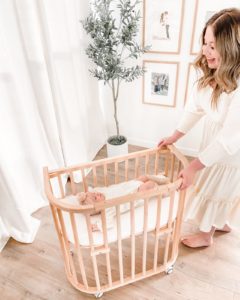
One thing that sets different bedside co-sleepers or cribs strongly apart are the materials used in their construction. The tough reality is: it’s still common for cribs and baby co-sleepers to be made with toxic glues, paints, and plastics that can be harmful to your baby’s health.
Certain paint finishes and glues release gasses that include formaldehyde, benzene, phenol, phthalates (and plenty of other ones that are equally hard to pronounce!) that can cause irritation, cause cancer, or damage the liver, kidney, and central nervous system.
And though these gasses can be harmful outdoors, they can be even more concentrated and harmful (10x more concentrated, in fact!) when they’re found on products indoors.
So when seeking out a crib or the best baby co-sleeper crib on the market, it’s not enough to just look for one that has checked off all the mandatory boxes. Look for one that has made smart and safety-centered choices when it comes to everything from engineering to construction.
How Does the babybay Baby Co-Sleeper Do Safety Differently?
As a company, babybay believes that your family’s health and safety is what matters most.
We were proud when we received the gold star for safety from ASTM International, TÜV Rheinland, and Confidence in Textiles (some of the biggest names in safety certification!). But that wasn’t enough for us.
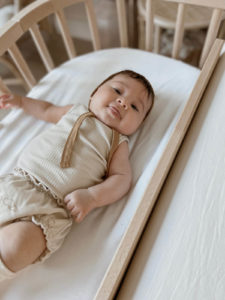
We wanted to check off all the safety boxes, and then go above and beyond in providing your baby with a made-just-for-them safe sleep space that doesn’t just give them security…but also you peace of mind.
That’s why we build all of our baby bedside sleepers using sustainably sourced and ethically manufactured 100% beechwood.
And our beechwood isn’t coated with chemicals. We keep it just as nature intended — non-toxic and pure.
This means you get to enjoy all the many benefits of co sleeping without worrying about whether the materials in your crib are hurting your baby’s health (because we’re always all-natural over here, all the time!).
So if you’re trying to decide what kind of baby bed is best for your family, understanding crib safety standards is a good place to start.
But then seek out the cribs and baby sleeper options that are going above and beyond when it comes to safety — and are committed to giving you and your baby better nights of rest.
